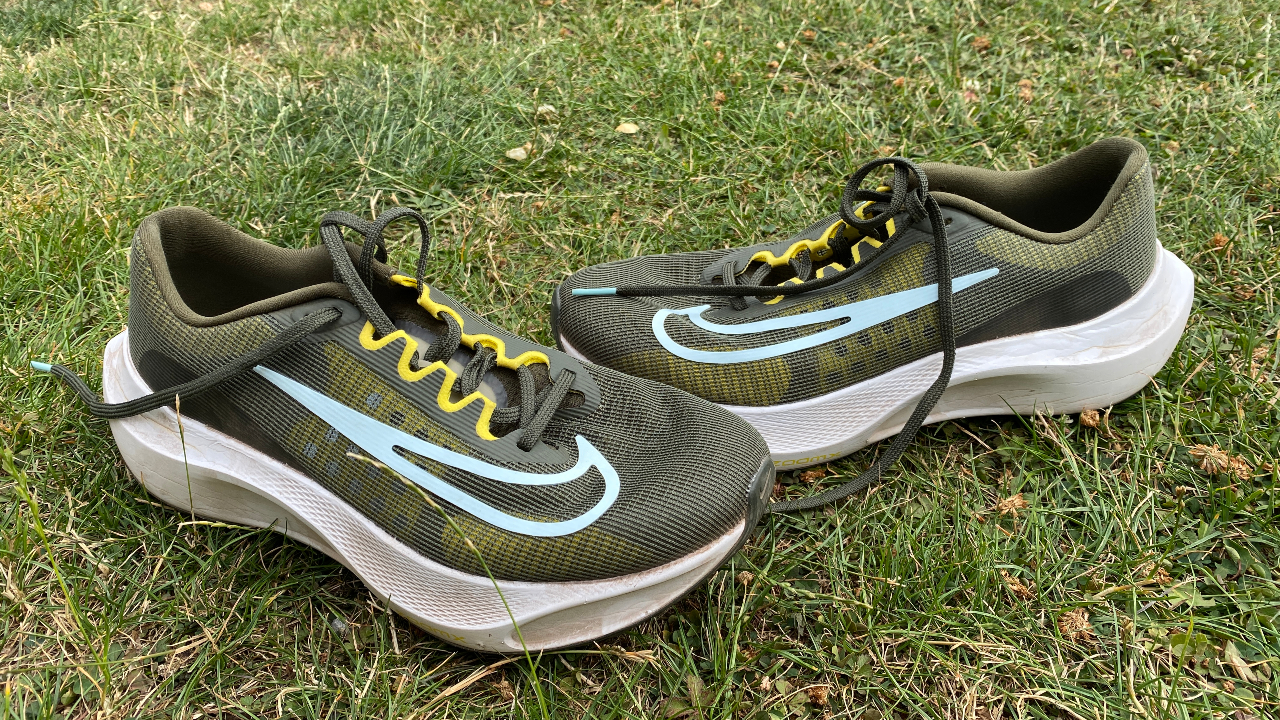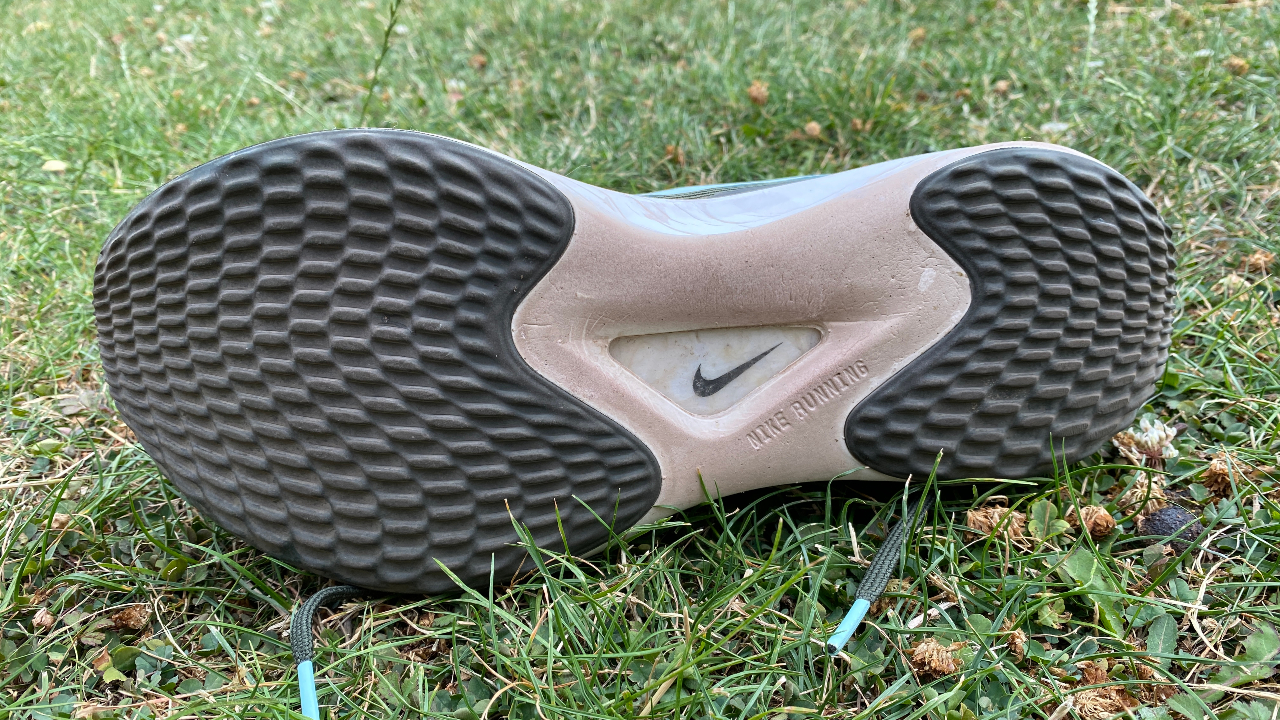Our Verdict
On paper, the updates made to the Zoom Fly 5 were exactly what the shoe needed in order to become a competitive plated training shoe. However, in reality it’s heavy, lacks a propulsive ride, and falls short of the standards set by the likes of the Saucony Endorphin Speed 3.
For
- Comfortable for easy runs
- Likely to be long-lasting
- Outsole grips well
Against
- Heavy
- Dull ride
- Better options available
You can trust Coach
The Nike Zoom Fly started life as the more accessible version of the Nike Vaporfly and, while it never matched the performance of Nike’s top racing shoe, it was a good-value, longer-lasting option. Early versions of the Zoom Fly were among the best running shoes you could get.
Unfortunately, the past couple of versions have seen the shoe get heavier and slower, and as well as falling well short of the performance of the best carbon plate running shoes, the Zoom Fly 4 was easily outgunned by fast training shoes like the Saucony Endorphin Speed.
Nike has made big changes to the Zoom Fly 5 and I had hoped these would make it a more compelling option but, while the shoe is a little better than the Zoom Fly 4, it’s still hard to recommend given the quality available elsewhere.
Nike Zoom Fly 5: Price And Availability

The Nike Zoom Fly 5 is available now and costs $160 in the US and £144.95 in the UK. It comes in much cheaper than Nike’s top carbon plate racing shoes, the Vaporfly NEXT% 2 at $225/£209.95 and the Nike Alphafly NEXT% 2 at $275/£274.95.
Design And Fit
The key update to the Zoom Fly 5 is in the midsole, which now contains the ZoomX foam used in the Vaporfly and Alphafly. ZoomX is lighter, bouncier and just faster than the React foam used in previous versions of the Zoom Fly, but before you start celebrating, there is a catch. Catches, actually.
For one, the ZoomX foam used is the recycled version found in shoes like the Alphafly Nature. Any move towards sustainability is to be applauded, but this ZoomX is heavier than the standard stuff. Also, using recycled materials results in variation in weights between shoes: one of the shoes in the pair I tested is 11.4oz/324g in a UK 8.5, the other is 10.7oz/304g. I’ve never seen such a disparity before, and whichever shoe you use it’s an increase on the Zoom Fly 4, which was 10.2oz/289g in a UK 9.
Even with recycled ZoomX that’s way heavier than you’d expect. The reason for the high weight is that the midsole is not just ZoomX. Surrounding the ZoomX core is an EVA foam called SR-02, which has nothing like the spring of ZoomX.
Sign up for workout ideas, training advice, reviews of the latest gear and more.
There is a full-length carbon plate running through the midsole as well, and the stack is high – Nike doesn’t give the official height but it looks to be around 40mm. The shoe has an 8mm drop from heel to toe.

The mesh upper provides a comfortable locked-down fit and there is extra cushioning around the tongue and collar. It’s not an upper that aims to trim weight in the way you might expect from a fast training shoe, which perhaps points to the idea that Nike is positioning this as a daily trainer.
That idea is backed up by the outsole, which has more extensive rubber coverage than on the Zoom Fly 4, with large sections on the forefoot and at the heel. It’s a good outsole that grips well on light trails, as well as the road, and should increase the durability of the shoe.
I tested a UK 8.5 Zoom Fly 5, which is half a size down on my normal size. It fit me well enough, but was cramped in the toe box on my right foot, so going true to size would probably be the best choice.
How I Tested This Shoe
I have run 50km in the Zoom Fly 5, including a mix of easy and steady runs, as well as a track session. I have run in all four of the previous models of the shoe as well.
Running Performance
It’s got a big Nike swoosh on the upper, a carbon plate in the midsole and it says ZoomX on the midsole, so you might be forgiven for thinking the Zoom Fly 5 is a speedster of a shoe. However, it is not a fast shoe, and the least enjoyable runs I did in it were those that involved any attempt to move beyond cruising pace.
I took it to the track to use for the first half of a session running 20 reps of 60 seconds on alternating with 60 seconds’ rest, aiming to run a bit faster than my 5K pace. The Zoom Fly 5 felt huge and blocky on the foot, and the midsole didn’t feel like it was delivering any kind of bounce or propulsion despite the foams and plate used.

In contrast, I also used the New Balance SuperComp Trainer during the same session, swapping after 10 reps, and the difference in feel was dramatic, with the New Balance bouncier and more enjoyable. The SuperComp Trainer is a higher-stack shoe – it towers over almost everything at 47mm – but crucially the foam used is all New Balance’s FuelCell, which isn’t as impressive as standard ZoomX but outperforms the recycled ZoomX/SR02 combo in the Zoom Fly 5.
Speed is not the Zoom Fly 5’s strength, then, but if you put preconceptions about how it should perform out of your mind, it is an enjoyable shoe to use for easy training runs. I found it has an efficient ride that helps you log a faster pace than you’d expect given your effort level or even heart rate – and if you keep to the lower heart-rate zones it’s a nice option for ticking off longer runs in particular.
If that sounds like faint praise, it’s because it is. If you’re just looking for a nice shoe to use for easy and long runs you can find better options that don’t have carbon plates and cost a lot less, like the Puma Velocity Nitro 2, which is also lighter and quicker than the Zoom Fly 5.
Is The Nike Zoom Fly 5 Worth It?
The Zoom Fly 5 isn’t a horrible shoe to run in and it has more bounce than the Zoom Fly 4, but to me it seems like a shoe without a purpose. It’s enjoyable to use for long, easy runs, but there are better cushioned shoes, such as the Brooks Glycerin 20, Puma Velocity Nitro 2 or Nike Invincible 2 if that’s all you want from it.
Then there’s the Saucony Endorphin Speed 3, which is more impressive on all fronts, and the New Balance SuperComp Trainer, which is ridiculously expensive at $180/£210 but bouncier and more comfortable than the Zoom Fly 5, while still being lighter despite its huge stack.
I also rate the Hoka Mach 5 as a better all-round training shoe. It’s much lighter and faster than the Zoom Fly 5 while being cheaper and less cumbersome on relaxed runs. The only similar shoe outperformed by the Zoom Fly 5 is the Hoka Bondi X, another hefty plated training shoe.
Nike is also set to resurrect the Pegasus Turbo line this year with the Pegasus Turbo Nature. If that comes close to the performance of the Turbo 1 and 2 then that will be another clear pick ahead of the Zoom Fly 5.

Nick Harris-Fry is a journalist who has been covering health and fitness since 2015. Nick is an avid runner, covering 70-110km a week, which gives him ample opportunity to test a wide range of running shoes and running gear. He is also the chief tester for fitness trackers and running watches, treadmills and exercise bikes, and workout headphones.

